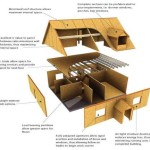Hurricane Proof House Plans are a set of architectural guidelines and specifications designed to enhance the structural integrity and resilience of homes against hurricanes and other severe weather events. They incorporate robust engineering principles and construction techniques to withstand high winds, heavy rainfall, and potential flooding, safeguarding the occupants and property.
Hurricane Ian, which devastated parts of Florida in 2022, vividly demonstrates the importance of hurricane-proof design. Homes that adhered to these standards suffered significantly less damage than those that did not, protecting lives and livelihoods in the face of extreme weather conditions.
As the frequency and intensity of hurricanes continue to escalate due to climate change, the demand for hurricane-proof house plans is on the rise. These plans provide homeowners with a roadmap to construct or remodel their homes with confidence, ensuring their safety and peace of mind during turbulent storms.
Hurricane proof house plans incorporate key design elements to enhance structural resilience and protect against hurricane damage:
- Reinforced concrete or steel frame
- Impact-resistant windows and doors
- Roofing designed for high wind loads
- Elevated foundation
- Water-resistant materials
- Storm shutters or hurricane panels
- Proper drainage and flood mitigation
- Backup power and communication systems
- Fire-resistant construction
By incorporating these features, hurricane proof house plans provide a comprehensive approach to safeguarding homes and their occupants from the devastating impacts of hurricanes and other severe weather events.
Reinforced concrete or steel frame
The foundation of a hurricane proof house plan lies in its structural framework. Reinforced concrete or steel frames provide exceptional strength and durability, forming the backbone of the house’s ability to withstand hurricane-force winds and other severe weather conditions.
Concrete is a versatile material renowned for its compressive strength, making it ideal for resisting the immense pressure exerted by hurricane winds. Steel, on the other hand, offers superior tensile strength, providing excellent resistance to bending and deformation. By combining these materials in a reinforced concrete or steel frame, engineers create a structure capable of withstanding extreme lateral forces and preventing catastrophic collapse.
The reinforcement process involves embedding steel bars or mesh within the concrete. This reinforcement significantly enhances the concrete’s tensile strength, preventing it from cracking or shattering under stress. Steel frames, on the other hand, are constructed from prefabricated steel beams and columns, which are then bolted or welded together to form a rigid framework.
In addition to providing structural integrity, reinforced concrete or steel frames also offer several other advantages. They are fire-resistant, providing protection against the spread of flames in the event of a fire. They are also resistant to termites and other pests, ensuring the long-term durability of the structure.
When combined with other hurricane-proofing measures, such as impact-resistant windows and doors, and a properly designed roof, a reinforced concrete or steel frame forms the cornerstone of a resilient and safe home that can withstand the fury of hurricanes and other extreme weather events.
Impact-resistant windows and doors
Impact-resistant windows and doors are a crucial component of hurricane proof house plans, engineered to withstand the impact of flying debris and high-velocity winds during hurricanes and other severe weather events.
- Laminated glass
Laminated glass is composed of two or more layers of glass bonded together with a durable plastic interlayer. This interlayer prevents the glass from shattering upon impact, keeping the window or door intact and preventing debris from entering the home. - Tempered glass
Tempered glass is a type of safety glass that is subjected to a controlled heating and cooling process, making it four to five times stronger than regular glass. When tempered glass breaks, it shatters into small, relatively harmless fragments, reducing the risk of injury. - Storm shutters
Storm shutters are exterior coverings designed to protect windows and doors from hurricane-force winds and debris. They are typically made from metal, plywood, or fabric, and can be installed over windows and doors before a storm to provide additional protection. - Hurricane panels
Hurricane panels are lightweight, removable panels that are installed over windows and doors to provide additional protection during hurricanes. They are typically made from polycarbonate or aluminum, and can be quickly and easily installed when a storm approaches.
Impact-resistant windows and doors not only protect the home from damage, but also provide peace of mind to homeowners during hurricanes and other severe weather events. By preventing debris from entering the home, they help to reduce the risk of injury and property damage, ensuring the safety and well-being of occupants.
Roofing designed for high wind loads
The roof of a hurricane proof house is engineered to withstand the immense wind forces generated by hurricanes and other severe weather events. Key design considerations include:
- Roof shape
Hip roofs and gable roofs with a low profile are preferred for hurricane-prone areas, as they offer less resistance to wind than other roof shapes. - Roofing materials
Asphalt shingles, metal roofing, and concrete tiles are commonly used in hurricane proof house plans due to their durability and wind resistance. These materials are designed to stay intact even under high wind loads, preventing leaks and damage to the roof structure. - Roof framing
The roof framing system, which includes trusses and rafters, is designed to resist uplift forces and prevent the roof from being torn off during a hurricane. Structural connectors, such as hurricane ties and straps, are used to securely attach the roof framing to the walls and foundation. - Roof decking
The roof decking, typically made from plywood or oriented strand board (OSB), provides a solid base for the roofing materials. It is securely attached to the roof framing to prevent it from blowing off in high winds.
By incorporating these design features, hurricane proof house plans ensure that the roof remains intact and secure, protecting the home and its occupants from the damaging effects of high wind loads.
Elevated foundation
An elevated foundation is a key component of hurricane proof house plans, designed to raise the home above potential floodwaters and protect it from storm surge, which is a sudden rise in sea level caused by hurricanes. By elevating the home, it is less likely to experience flooding and water damage, which can be catastrophic and costly.
There are several types of elevated foundations used in hurricane proof house plans:
- Crawlspace foundation
A crawlspace foundation elevates the home a few feet above the ground, creating a crawlspace beneath the house. The crawlspace is typically enclosed with a vapor barrier and vented to prevent moisture and pests from entering the home. - Pier and beam foundation
A pier and beam foundation elevates the home on a series of piers or columns, which are typically made from concrete or steel. The beams are then attached to the piers and support the floor of the home. - Slab-on-grade foundation
A slab-on-grade foundation is a concrete slab that is poured directly on the ground. To make it hurricane resistant, the slab is elevated on a raised foundation wall or piers.
The height of the elevated foundation is determined by local building codes, which are based on the flood risk in the area. In areas with a high risk of flooding, homes may be required to be elevated several feet above the ground.
Elevated foundations provide several benefits in addition to flood protection. They also help to protect the home from termites and other pests, and they can improve ventilation and airflow beneath the home, which can help to reduce moisture and mold problems.
Water-resistant materials
Water-resistant materials play a crucial role in hurricane proof house plans, protecting the home and its occupants from water damage caused by hurricanes and other severe weather events.
Water can enter a home through a variety of openings, including windows, doors, roofs, and foundations. Hurricane proof house plans incorporate water-resistant materials and techniques to seal these openings and prevent water from penetrating the home’s interior.
Some of the most commonly used water-resistant materials in hurricane proof house plans include:
- Water-resistant siding
Water-resistant siding is designed to withstand moisture and prevent water from penetrating the walls of the home. It is typically made from materials such as vinyl, fiber cement, or metal, which are resistant to rot, decay, and water damage. - Water-resistant roofing materials
Water-resistant roofing materials are designed to shed water and prevent it from leaking into the home. They are typically made from materials such as asphalt shingles, metal roofing, or concrete tiles, which are waterproof and durable. - Water-resistant windows and doors
Water-resistant windows and doors are designed to keep water out of the home, even during heavy rain and wind. They typically feature tight seals and gaskets to prevent water from seeping through the cracks. - Water-resistant foundation materials
Water-resistant foundation materials are designed to protect the foundation of the home from water damage. They are typically made from materials such as concrete, which is waterproof and durable.
In addition to using water-resistant materials, hurricane proof house plans also incorporate other techniques to prevent water from entering the home, such as proper drainage systems, grading, and landscaping to direct water away from the home’s foundation.
Storm shutters or hurricane panels
Storm shutters and hurricane panels are exterior coverings designed to protect windows and doors from hurricane-force winds and debris. They are a crucial component of hurricane proof house plans, providing an additional layer of protection to the home’s most vulnerable openings.
Storm shutters are typically made from metal, plywood, or fabric, and are installed over windows and doors before a storm to provide additional protection. They are designed to withstand high wind loads and impact from flying debris, preventing damage to the windows and doors and reducing the risk of water infiltration.
Hurricane panels are lightweight, removable panels that are installed over windows and doors to provide additional protection during hurricanes. They are typically made from polycarbonate or aluminum, and can be quickly and easily installed when a storm approaches. Hurricane panels are a convenient and effective way to protect windows and doors from hurricane damage, and they can be stored away when not in use.
Both storm shutters and hurricane panels offer a range of benefits for hurricane proofing homes. They help to protect windows and doors from damage, reduce the risk of water infiltration, and provide peace of mind to homeowners during hurricanes and other severe weather events.
When choosing storm shutters or hurricane panels, it is important to consider the following factors:
- Material
Storm shutters and hurricane panels are available in a variety of materials, including metal, plywood, fabric, polycarbonate, and aluminum. The best material for your home will depend on your budget, the level of protection you need, and the aesthetic appeal you desire. - Installation
Storm shutters and hurricane panels can be installed in a variety of ways, including permanent installation, removable installation, and accordion-style installation. The best installation method for your home will depend on your needs and preferences. - Cost
The cost of storm shutters and hurricane panels varies depending on the material, size, and installation method. It is important to compare costs from different suppliers to find the best option for your home.
By carefully considering these factors, homeowners can choose the best storm shutters or hurricane panels for their hurricane proof house plans, ensuring the safety and protection of their home during hurricanes and other severe weather events.
Proper drainage and flood mitigation
Proper drainage and flood mitigation are essential components of hurricane proof house plans, designed to protect the home and its occupants from flooding and water damage caused by hurricanes and other severe weather events.
- Grading and landscaping
Grading and landscaping can be used to direct water away from the home’s foundation and prevent flooding. Grading involves sloping the land around the home so that water flows away from the foundation. Landscaping can be used to create natural barriers, such as berms and swales, to further direct water away from the home. - Gutters and downspouts
Gutters and downspouts are an important part of a proper drainage system. Gutters collect rainwater from the roof and direct it into downspouts, which then channel the water away from the foundation. It is important to ensure that gutters and downspouts are properly sized and maintained to effectively handle heavy rainfall. - French drains
French drains are underground trenches filled with gravel or perforated pipe that are used to collect and drain water away from the home’s foundation. They are typically installed around the perimeter of the home and can be connected to a sump pump to remove water from the drain. - Sump pumps
Sump pumps are used to remove water from the basement or crawlspace of a home. They are typically installed in a sump basin, which is a pit dug below the floor level of the home. When the water level in the sump basin rises, the sump pump turns on and pumps the water out of the home.
By incorporating proper drainage and flood mitigation techniques into hurricane proof house plans, homeowners can reduce the risk of flooding and water damage to their homes, ensuring the safety and well-being of their families and property.
Backup power and communication systems
Backup power and communication systems are essential components of hurricane proof house plans, designed to ensure that homes remain habitable and occupants can stay connected during and after hurricanes and other severe weather events.
- Backup generators
Backup generators provide a reliable source of electricity when the main power grid is down. They are typically powered by gasoline, diesel, or natural gas, and can be used to power essential appliances, lighting, and other devices. Backup generators are especially important for homes that rely on electricity for medical equipment, refrigeration, or other critical needs.
- Solar panels and batteries
Solar panels and batteries can provide a renewable and sustainable source of backup power. Solar panels convert sunlight into electricity, which is then stored in batteries for use when needed. Solar panels and batteries are a good option for homes that want to reduce their reliance on fossil fuels and have a more environmentally friendly backup power system.
- Satellite phones and two-way radios
Satellite phones and two-way radios can provide communication when traditional phone lines and cellular networks are down. Satellite phones are especially useful in remote areas or during widespread power outages. Two-way radios can be used for communication between family members or neighbors, and can be especially helpful for coordinating emergency response efforts.
- Emergency communication plans
Emergency communication plans are essential for ensuring that family members can stay connected and informed during and after hurricanes and other severe weather events. These plans should include a designated meeting place, a way to contact each other if separated, and a list of emergency contacts.
By incorporating backup power and communication systems into hurricane proof house plans, homeowners can ensure that their homes remain habitable and that they can stay connected during and after hurricanes and other severe weather events.
Fire-resistant construction
Fire-resistant construction is an essential component of hurricane proof house plans, designed to protect homes and their occupants from the risk of fire, which can be exacerbated during hurricanes due to downed power lines, leaking gas lines, and other hazards.
- Fire-resistant building materials
Fire-resistant building materials, such as concrete, masonry, and steel, are used in the construction of hurricane proof homes to prevent the spread of fire. These materials are non-combustible or slow to burn, providing valuable time for occupants to evacuate and for firefighters to respond.
- Fire-resistant roofing
Fire-resistant roofing materials, such as metal roofing, tile roofing, and asphalt shingles with a Class A fire rating, are used to protect hurricane proof homes from roof fires. These materials are designed to resist ignition and spread of flames, preventing the fire from spreading to the rest of the home.
- Fire-rated windows and doors
Fire-rated windows and doors are designed to slow the spread of fire and provide a barrier against flames and smoke. They are typically made from materials such as steel, aluminum, and fiberglass, and are tested to withstand fire for a specific period of time.
- Fire sprinklers
Fire sprinklers are an effective way to suppress fires and reduce the risk of fire damage. They are installed throughout the home, including in the kitchen, bedrooms, and living areas. When a fire occurs, the sprinklers automatically activate and spray water to extinguish the flames.
By incorporating fire-resistant construction techniques into hurricane proof house plans, homeowners can significantly reduce the risk of fire damage to their homes and protect the safety of their families and property.










Related Posts








